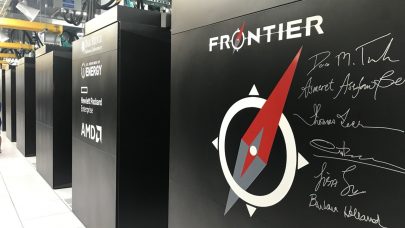
Exascale Frontier Supercomputer Has Passed Formal Acceptance: What That Means
May 22, 2023
Fresh off their third Top500 win for Frontier – now with an 8.4% higher Linpack score – the HPC team at Oak Ridge National Laboratory had some exciting news to share today. Frontier has passed its acceptance and is taking on grand scientific challenges. “Acceptance of Frontier took place at the... Read more…

Exascale Frontier Supercomputer Hosts Trio of New Cosmological Codes
April 27, 2023
Oak Ridge National Laboratory's exascale Frontier supercomputer – the first public exascale system in the world – debuted almost a year ago. Now, more and m Read more…

DOE and ORNL Dedicate Frontier Supercomputer
August 17, 2022
“It is my privilege to welcome you to the dedication of Frontier, the supercomputer that broke the exascale barrier.” That was the introduction by Oak Ridge National Laboratory Director Thomas Zacharia, at a small, public event on August 17 to officially dedicate the supercomputer, which in May became the first system to achieve over 1.0 exaflops of 64-bit performance on the... Read more…

Q&A with ORNL’s Bronson Messer, an HPCwire Person to Watch in 2022
August 12, 2022
HPCwire presents our interview with Bronson Messer, distinguished scientist and director of Science at the Oak Ridge Leadership Computing Facility (OLCF), ORNL, and an HPCwire 2022 Person to Watch. Messer recaps ORNL's journey to exascale and sheds light on how all the pieces line up to support the all-important science. Also covered are the role... Read more…

ORNL’s Supercomputer-Powered TRITON Tool Models Flooding
August 3, 2022
Rare, severe flooding struck both Kentucky and Missouri in the last week alone — and with climate change accelerating, such events are likely to continue. However, flood modeling remains computationally expensive. Now, researchers from Oak Ridge National Laboratory (ORNL) and Tennessee Technological University have created the TRITON toolkit, which leverages... Read more…

Summit Spins Up Research for Streamlined Carbon Fiber Production
July 1, 2022
Oak Ridge National Laboratory’s exascale Frontier system may be stealing some of the spotlight, but the lab’s 148.6 Linpack petaflops Summit system is still Read more…

US Pursues Next-gen Exascale Systems with 5-10x the Performance of Frontier
June 28, 2022
With the Linpack exaflops milestone achieved by the Frontier supercomputer at Oak Ridge National Laboratory, the United States is turning its attention to the next crop of exascale machines, some 5-10x more performant than Frontier. At least one such system is being planned for the 2025-2030 timeline, and the DOE is soliciting input from the vendor community... Read more…

At ISC, the Green500 Witnesses a New Frontier in Efficient Computing
June 8, 2022
Back in 2008, the U.S. Defense Advanced Research Projects Agency (DARPA) set an ambitious target: an exascale supercomputer in a 20-megawatt envelope. That targ Read more…

- Click Here for More Headlines

Whitepaper
Transforming Industrial and Automotive Manufacturing
In this era, expansion in digital infrastructure capacity is inevitable. Parallel to this, climate change consciousness is also rising, making sustainability a mandatory part of the organization’s functioning. As computing workloads such as AI and HPC continue to surge, so does the energy consumption, posing environmental woes. IT departments within organizations have a crucial role in combating this challenge. They can significantly drive sustainable practices by influencing newer technologies and process adoption that aid in mitigating the effects of climate change.
While buying more sustainable IT solutions is an option, partnering with IT solutions providers, such and Lenovo and Intel, who are committed to sustainability and aiding customers in executing sustainability strategies is likely to be more impactful.
Learn how Lenovo and Intel, through their partnership, are strongly positioned to address this need with their innovations driving energy efficiency and environmental stewardship.
Download Now
Sponsored by Lenovo
Whitepaper
How Direct Liquid Cooling Improves Data Center Energy Efficiency
Data centers are experiencing increasing power consumption, space constraints and cooling demands due to the unprecedented computing power required by today’s chips and servers. HVAC cooling systems consume approximately 40% of a data center’s electricity. These systems traditionally use air conditioning, air handling and fans to cool the data center facility and IT equipment, ultimately resulting in high energy consumption and high carbon emissions. Data centers are moving to direct liquid cooled (DLC) systems to improve cooling efficiency thus lowering their PUE, operating expenses (OPEX) and carbon footprint.
This paper describes how CoolIT Systems (CoolIT) meets the need for improved energy efficiency in data centers and includes case studies that show how CoolIT’s DLC solutions improve energy efficiency, increase rack density, lower OPEX, and enable sustainability programs. CoolIT is the global market and innovation leader in scalable DLC solutions for the world’s most demanding computing environments. CoolIT’s end-to-end solutions meet the rising demand in cooling and the rising demand for energy efficiency.
Download Now
Sponsored by CoolIT
Advanced Scale Career Development & Workforce Enhancement Center
Featured Advanced Scale Jobs:
HPCwire Resource Library
HPCwire Product Showcase
© 2024 HPCwire. All Rights Reserved. A Tabor Communications Publication
HPCwire is a registered trademark of Tabor Communications, Inc. Use of this site is governed by our Terms of Use and Privacy Policy.
Reproduction in whole or in part in any form or medium without express written permission of Tabor Communications, Inc. is prohibited.
























